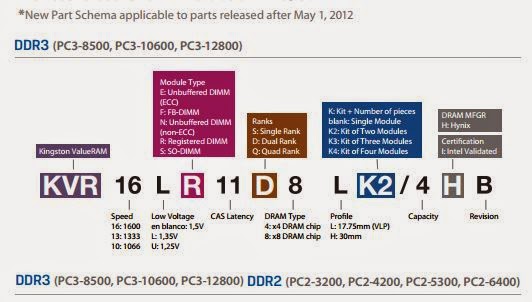Friday, December 12, 2014
Memory Kingston naming convention and guide
Rank: Single, Dual, Quad Rank Memory Modules
Important when installing memory modules in workstations and
servers. If the total number of ranks installed exceeds the system’s
memory speci cations, the system may not boot, may have memory
errors, or may not recognize part of the memory capacity. Check your
system’s user guide for supported number of ranks.
x4 or x8 DRAM Organization
Registered DIMMs for servers are available with x4 (“By 4”) or x8 DRAM
chips. x8-based server modules are generally more cost-e ective but
only x4-based server modules can support server features such as
multiple-bit error correction, Chipkill, memory scrubbing, and Intel
Single Device Data Correction (SDDC).
Capacity
Total number of memory cells on a module expressed in Megabytes
or Gigabytes. For kits, listed capacity is the combined capacity of all
modules in the kit.
CAS Latency
One of the most important latency (wait) delays (expressed in clock
cycles) when data is accessed on a memory module. Once the data
read or write command and the row/column addresses are loaded, CAS
Latency represents the ( nal) wait time until the data is ready to be read
or written.
DDR3
Third-generation DDR memory technology. DDR3 memory modules
are not backward-compatible with DDR or DDR2 due to lower
voltage (1.5V), di erent pin con gurations and incompatible memory
chip technology.
ECC
(Error Correction Code) A method of checking the integrity of the data
stored in the DRAM module. ECC can detect multiple-bit errors and can
locate and correct single-bit errors.
Intel Validated
Parts with this designation have been validated by Intel’s authorized
validation lab for their server platforms.
Subscribe to:
Posts (Atom)
